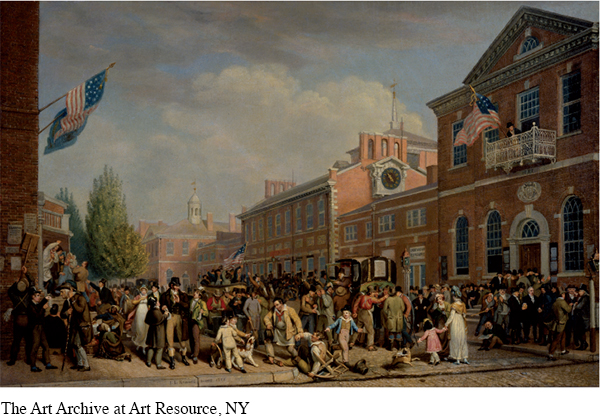Expanding Voting Rights
Between 1788 and 1820, the U.S. presidency was dominated by Virginia elites and after 1800 by Democratic-Republicans. With little serious political opposition at the national level, few people bothered to vote in presidential elections. Far more people engaged in political activities at the state and local levels. Many towns attracted large audiences to public celebrations on the Fourth of July and election days. Female participants sewed symbols of their partisan loyalties on their clothes and joined in parades and feasts organized by men.
The panic of 1819 stimulated even more political activity as laboring men, who were especially vulnerable to economic downturns, demanded the right to vote so they could hold politicians accountable. In New York State, Martin Van Buren, a rising star in the Democratic-Republican Party, led the fight to eliminate property qualifications for voting. At the state constitutional convention of 1821, the committee on suffrage argued that the only qualification for voting should be “the virtue and morality of the people.” By the word people, Van Buren and the committee meant white men.

Despite opposition from powerful and wealthy men, by 1825 most states along the Atlantic seaboard had lowered or eliminated property qualifications on white male voters. Meanwhile states along the frontier that had joined the Union in the 1810s established universal white male suffrage from the beginning. And by 1824 three-quarters of the states (18 of 24) allowed voters, rather than state legislatures, to elect members of the electoral college.
Yet as white workingmen gained political rights in the 1820s, democracy did not spread to other groups. Indian nations were considered sovereign entities, so Indians voted in their own nations, not in U.S. elections. Women were excluded from voting because of their perceived dependence on men. And African American men faced increasing restrictions on their political rights. No southern legislature had ever granted blacks the right to vote, and northern states began disfranchising them as well in the 1820s. In many cases, expanded voting rights for white men went hand in hand with new restrictions on black men. In New York State, for example, the constitution of 1821, which eliminated property qualifications for white men, raised property qualifications for African American voters.
When African American men protested their disfranchisement, some whites spoke out on their behalf. They claimed that denying rights to men who had in no way abused the privilege of voting set “an ominous and dangerous precedent.” In response, opponents of black suffrage offered explicitly racist justifications. Some argued that black voting would lead to interracial socializing, even marriage. Others feared that black voters might hold the balance of power in close elections, forcing white civic leaders to accede to their demands. Gradually, racist arguments won the day, and by 1840, 93 percent of free blacks in the North were excluded from voting.
Exploring American HistoriesPrinted Page 291
Exploring American Histories Value EditionPrinted Page 219
Chapter Timeline